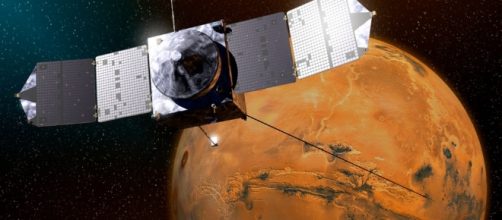NASA’s spacecraft MAVEN, an acronym for Mars Atmosphere and Volatile EvolutioN, has been orbiting Mars in a successful attempt to study its atmosphere. On its previous path, the orbiter was close to colliding with the Martian moon Phobos.
Change in course
The spacecraft performed a rocket burn maneuver changing its speed by less than a mile per hour. Previously, the orbiter was expected to be within seven seconds of Phobos. On its new course, the Martian orbiter will miss the moon by two and a half minutes. The precision of NASA’s technology and the team from the Jet Propulsion Laboratory allows for avoiding any possible threats and danger.
The elliptical orbits of Phobos and the Martian orbiter create complicated situations for NASA’s team. Bruce Jarosky the primary investigator of the spacecraft gives credit to the Jet Propulsion Laboratory (JPL) who monitor for collisions. With their creation of Multi-Mission Automated Deep-Space Conjunction Assessment Process, members of JPL receive accurate data of possible collisions. With the creation of such groups, major disasters that impede scientific advancement are constantly avoided.
Studying the Martian atmosphere
News of MAVEN’s near-collision brings to light the ongoing efforts of scientists in researching Mars’ atmosphere. The spacecraft has been studying the Martian atmosphere since 2013.
Scientists believe that Mars possessed a magnetic field shielding its atmosphere much like that of Earth’s. Because of spacecrafts like MAVEN, evidence has confirmed the theory of scientists.
The theory also explains how Mar’s atmosphere deteriorated into what it has become today. Evidence suggests water was prevalent throughout Mars.
At some point, the magnetic of Mars ceased to exist. The solar winds continued to deplete Mar’s remaining atmosphere. As it is, Mars remains a cold and dry environment unsuitable for supporting life. The desolate wasteland contrasts with the flourishing green ecosystems of Earth.
The future of Mars
Plans for human exploration of Mars are still in development.
With advancing research and technology, these plans aren’t far from the future. People like Elon Musk plan on going as far as colonizing the planet. Although the idea might have been seen as far out of reach, the collaboration of large corporations and leading business leaders has taken a hold on the space exploration sector. Space exploration has seen huge leaps without any large help of the government. With the help of MAVEN and more technology yet to come, humanity’s first physical contact with Mars inches closer.

